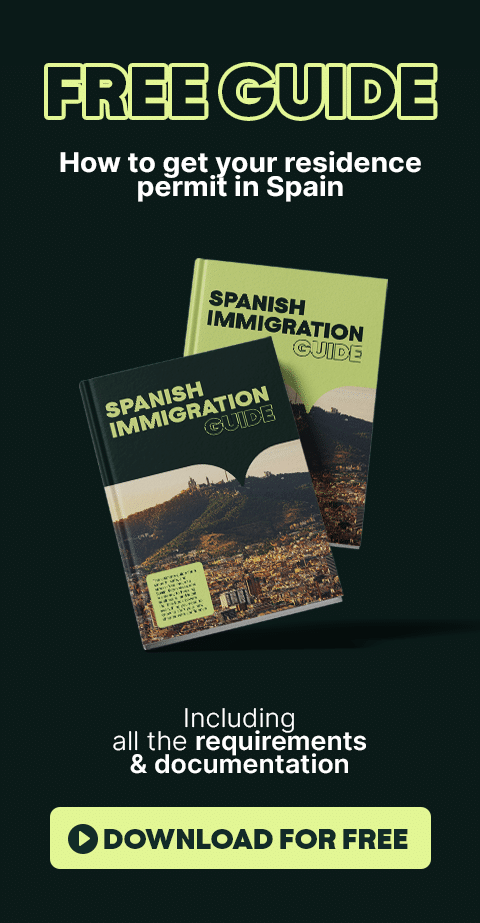Whether you have just received your citizenship resolution and it is favorable, you are waiting for it or you are going to submit your application soon, keep reading. In this article you will find out how the last phase of the process works (in detail): the Spanish oath of citizenship. We are about to analyze how this step exactly works and where is it carried out, how much time you have to do it once you receive your favorable resolution, what questions you will be asked on the day of the appointment, and legal advice that will be very useful to complete the process successfully.
What is the oath of citizenship?
Once you have been granted Spanish nationality, you will still have to take one last step to complete the process: to swear or promise to respect the Spanish Constitution and its laws.
And that process is called citizenship oath.
Even though it is a very simple procedure, it requires following the formal steps that we will analyze in this article.
You have two different, but equally valid, ways to formalize this respect for the Spanish legal system:
- Either you can complete it by swearing
- Or you by promising (in the latter case there would be no religious connotation associated)
But, again, both options are completely equivalent legally speaking
Through this procedure, you will be registered for the first time in Spain as a national through the birth certificate; and, depending on your country of origin, it will be the moment when you will have to renounce your nationality of origin in order to acquire the Spanish one (if you cannot keep the dual nationality).
Hence, once you receive the resolution stating that you have been favorably granted Spanish nationality, what you will have to do immediately (and now you will understand why so fast) is to request an appointment for this last phase of the process.
And this can be done in two at two different institutions.
Where is the oath taken?
Currently, there are two different options or locations to take the oath of nationality:
- At the nearest Civil Registry Office
- Before a notary or at the Spanish consulate
Although it is true that traditionally this procedure could only be carried out at the Civil Registry, recently the possibility of doing it before a notary was incorporated, something that can be very advantageous due to the long waits involved in making an appointment in the first option.
Thus, taking the oath before a notary may be your best alternative (especially if you live in a big city).
To understand how the process typically goes, you must first go to the nearest Civil Registry to make an appointment, and there you will be given a specific date to come back and carry out the procedure. However, it is true that nowadays many civil registries have an online platform where you can request an appointment.
Can I make an appointment at any Civil Registry in Spain? No. You will have to do it in the one that corresponds to you according to the municipality in which you are registered at the time of receiving the nationality resolution.
That is to say, if when you applied for nationality and submitted your application you lived in a municipality but between that submission and the resolution you have moved elsewhere, the municipality of reference will be the latter (the one in which you live at the time of receiving the notification).
When do I have to take the oath? Deadlines
This is very important: you have a period of 180 days to make an appointment to take the oath, time that starts counting from the very moment in which you are granted nationality.
Here we must emphasize that you cannot start this swearing-in process until you receive the nationality resolution officially.
That is to say, to see the “resuelto favorable” in the online platform “cómo va lo mío” is not enough to be able to take the oath.
Thus, you must fully consider this 6 month period; because exceeding it would mean the loss of the process and of your right to be a Spanish citizen (because your file would turn into “archivado” status and with it your nationality would be lost).
Therefore, our recommendation is that you do it with time and ask for an appointment as soon as possible; since many civil registries (especially those of the big capitals such as Madrid or Barcelona) are saturated and can take a long time to give you an appointment.
Nevertheless, if you have requested your appointment immediately and it is granted after 180 days, there would be no problem, since you would already have the appointment and it would be sufficient justification.
Do you have any questions? Ask our expert nationality lawyers, or continue reading this article for more information:
Documents to bring with you on the day of the appointment
On the day of the oath, what documents should you bring with you?
Mainly the following:
- Favorable resolution of Spanish nationality and its receipt
- Passport, which must be the original and in force
- Residence card, which must be valid and in force (you cannot be in an irregular situation at that moment) or receipt if you are in the middle of a renewal
- City hall registration (“padrón”)
- Birth certificate (the same one you used in the application for nationality)
- Criminal records certificate (legalized or apostilled)
- Declaratory data sheet, document in which basic information such as name, surname, or place of birth is collected
It is important to mention that the certificate of criminal records and birth certificate are two documents that you should not provide if you have submitted your nationality application through the Civil Registry. Only if you did it online you will have to provide them again at the oath ceremony.
What is done on the day of the oath and how long does it last?
Contrary to what many tend to think, the nationality oath is a very simple and easy procedure.
On the day of your appointment, you will first have to hand in your favorable citizenship resolution, so that the public clerk in charge can verify its validity.
Once verified, you will be asked two very simple questions (which we will see in the following section), and with that, you will be registered in the Civil Registry as a Spanish citizen through your birth certificate.
In terms of time, the process is usually completed that same day, and the oath per se does not last more than 30 minutes.
However, it is also possible that the process is divided into two parts as the public worker submits your file to another official, and the process is completed in a few days or weeks.
Spanish citizenship Oath before a notary
How does the process work if you would like to proceed before a notary?
First of all, once you are granted your citizenship favorable resolution and receive the notification from the Ministry of Justice, you must submit your application to the College of Notaries located in your province to carry out the oath of allegiance (in case you choose this path and decide not to proceed with the Civil Registry).
After what will probably be 1 or 2 weeks of waiting (we still don’t know exactly how long it will take), the College will assign you a notary on duty to whom you will have to visit.
Once you know which notary has been assigned to you, you will have to go to her office with all the required documentation (together with your NIE) to take the oath to the Constitution and the Spanish.
Keep in mind that initially, this procedure may take a little longer, as it is something that these notaries are not yet used to perform.
In addition, we do not know in what way the current health measures will alter and make everything slower (for example with a lower frequency of appointment dates).
In any case, once the oath is formalized, the notary will send the file to the Civil Registry, who will make the registry entry with the registration of the Spanish birth certificate.
Taking the oath at the notary’s office will be a great alternative to save time in obtaining the nationality; although it depends on which city you are currently living in.
For in those places where the appointments at the Civil Registry already work properly without much delay, it may not be that necessary.
However, if you live in a big city and it was quite difficult for you to get an appointment for the oath, the notary is now your best ally.
DICIREG, the IT platform that will bring it all together
As we mentioned in the previous section, it will be the notary who will contact the Civil Registry to send all the information relevant to the oath so that the final registration can be carried out.
But here we will find a difference.
There is a new electronic system, an application called DICIREG that communicates and connects the notary’s office with the Civil Registry.
This system is not yet implemented in all cities, so it may not be as automatic everywhere.
That is to say, in certain municipalities where DICIREG is not in operation, the notary will perform the oath but then the person in charge of the Civil Registry, upon receiving the file, will have to make a prior analysis and assessment before being able to perform the registration (something that could delay the process a little more).
In other words, in some cases the notification will be sent electronically and immediately, while in others it will be sent “offline” through paper.
Will I be able to choose any notary to take the oath?
Unfortunately, no: the notary with whom you will carry out the procedure will not be something you will be able to freely choose.
For the time being, it will be the Spanish College of Notaries itself who will assign you a notary on duty.
Those notaries who handle a greater number of procedures and files on a daily basis will be excluded (i.e., the largest and most saturated notary’s offices will be excluded and will not be able to perform this procedure), so that those who have greater availability can handle it faster.
The fact of not being able to choose a notary office could make the process a bit more inefficient and slower, as you will have to go through this extra step of having to contact the Colegio de Notarios and wait for the assignment of a professional.
What questions will you be asked on the day of the nationality oath?
This procedure revolves around two key questions that you will have to answer affirmatively.
More specifically, on the day of the oath you will be asked:
- If you swear to respect the Spanish legal system and its constitution
- If you agree to renounce your nationality of origin (only if necessary since you cannot maintain dual nationality)
And that’s it!
What happens after this process is completed?
Once you have completed the process of the oath of nationality and you have been registered in the Civil Registry as a Spaniard through your birth certificate, the next step is to make an appointment at the police station to get your Spanish ID card and passport.
Here is the link to make an appointment
In addition, you will have to request the “certificado de concordancia” to be able to change your name with the different institutions where you were registered in Spain; a very important procedure that many foreigners (now Spaniards) forget.
In all the institutions in which you have been registered during your life in Spain as a foreigner before obtaining the nationality, you have done it with your name as it appears in your original document. And, on many occasions, when you register in the Spanish Civil Registry as a national of the country, your name and surnames may slightly vary, adding a second surname if you did not have it, etc.
Thus, you will have to carry out this identity verification stating that you are still the same person, but now with your data as it appears in your Spanish DNI or passport.
Differences between “jura” and “prejura”
Finally, it is important to understand that this process could be divided into 2 steps, especially if you carry out the procedure in a crowded Civil Registry: the “prejura” and the “jura”.
How does the process work in this case?
In the “prejura”, a series of key data is collected for the day of the oath, the information sheet that we have seen in the section on documents.
We are talking about key information for your registration in the birth certificate; and you will do so by signing a declaration of data collection, specifying your name, surname, place of birth, parents’ names, etc.
Once this first phase is finished, you will have to return another day to the Civil Registry to take the oath and to answer the 2 necessary questions that we have seen before, now the whole process is finished.
Do you still have doubts or do you need specialized legal help to process the oath or get your Spanish nationality? We can help you!
Book a consultation with one of our lawyers and solve all your doubts:

At Balcells Group we have been foreigners effortlessly moving to Spain for over 11 years. We help expats from all around the world with their immigration, business, tax and legal needs; ensuring a legally safe and enjoyable transition to the Spanish territory. Our multilingual team understands the importance of adapting to the cultural and legal specificities of our international clients. We offer a comprehensive service that combines the expertise of several generations of lawyers with the innovation needed to address today’s legal challenges, always striving to simplify processes and ensure reliable, effective results.



